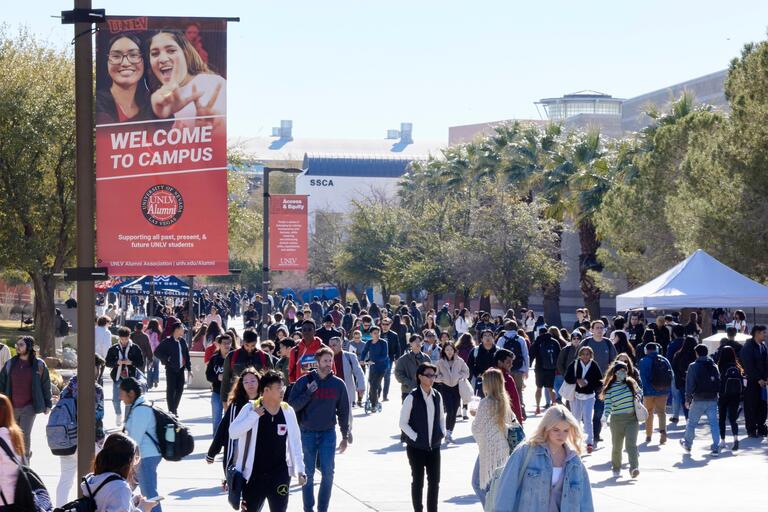Parking may be the white whale of the UNLV campus, but chalk one up for Ahab this month.
The Environmental Protection Agency is due to leave its buildings in the center of campus by 2020, but the agency already ceded one building back to the university. The EPA's Environmental Assessment Exposure building, which was used as a greenhouse, has been razed. The new lot, north of the Herman Westfall Building and east of Lot L, is opening in time for National Finals Rodeo, which comes to the Thomas & Mack Center this week.
It’s not the only vehicle-related change on the main campus. Anyone who frequents the east side of the university has seen the push-button crosswalk across Maryland Parkway at Del Mar Street replaced by a full signal. It should improve traffic flow and safety — drivers won’t have to endure the dribs and drabs of people crossing at will while a red light ensures cars stop for pedestrians.
“We worked with the county for about a year to see if they were willing to put in a signal. The county agreed, and they agreed to fund it, too — they have been a great partner in this project and the pedestrian safety improvement it establishes,” said David Frommer, UNLV planning and construction executive director.

Big Projects on the Horizon
Maryland Parkway itself soon will be a target for renovation. The county is expected to resurface the street in two phases: from Flamingo to Desert Inn Road first, then Flamingo to Russell Road. The project, currently in the design/pre-construction phase, will include some underground work for utilities and is expected to be a lengthy process. But the work will be to UNLV’s and the greater community’s benefit; it will include improving sidewalks along the road for accessibility and potentially realigning Cottage Grove Avenue to form a four-way intersection with Rochelle Avenue.
With a refreshed Maryland corridor, one new building expected to add to the front-door experience is the Lee Business School. Though early in the concept phase, to the point where fundraising goals haven’t yet been set, the new building would sit in the space between the Richard Tam Alumni Center and the Flora Dungan Humanities Building.
"A new Business School building is a high priority for the university,” Frommer said, noting the school’s large and growing student population. “Whether it goes forward in its current iteration or gets refined to a different size, scope, and cost projection, is an outstanding question. Frank and Estella Beam Hall is a very good and valued university building, but it does not represent the ‘state-of-the art’ for a contemporary business college building facility and experience.”
Beam Hall, already opening up space when the Hospitality College moves to its new home in Hospitality Hall before the spring semester, would eventually be repurposed for use by other programs, he said.

Howard R. Hughes College of Engineering is also in the new-building hunt, with an expansion in the early planning stages between Artemus W. Ham Concert Hall and Thomas T. Beam Engineering Complex.
“Engineering was approved for planning funds, $3.5 million in a 50/50 split [with the state],” Frommer said. “That's got planning money assigned to it, while the business college is not yet at that point. The engineering facility is a little bit ahead in the capital project cycle/process.”
Even further out is the 42-acre site at Tropicana Avenue and Koval Lane. The likely use for that parcel will be to see it develop into a center for educational outreach, graduate and professional students, and possibly including medical and dental clinics. It’s envisioned as a place for students who need to come in, go to a class, and then get out and on with their work and family lives without navigating the main campus.
On the Shadow Lane campus, future home of the Medical School’s first dedicated building, there’s still plenty of fundraising to go, but construction is targeted to begin before the school's next major accreditation visit in July 2021.
“Once the planning is done — and the planning could take 12-18 months for the design, permits, things like that — we believe the construction could be anywhere from 24 to 30 months depending on the scale and size,” Frommer said. “It will be a fairly large, significant building. And it's a fairly complex building. For instance, my understanding is UNLV may be the first program that goes to fully virtual anatomy. The demands of the technology for a virtual anatomy experience are entirely different from a traditional anatomy educational experience.’
Those are the buildings coming, but there will eventually be those going, too. Archie C. Grant Hall is slated for ongoing maintenance to its existing systems to keep it operational, but it’s only a matter of time before replacement is on the docket.
With space tight across campus, Frommer said, “we have to keep Grant Hall operating until we are able to replace it. If the funding were available today, we would do that. It is in the later stages of its life.”
The nearly 60-year-old building is one of the oldest campus buildings remaining, and has served several purposes and programs over its life.


